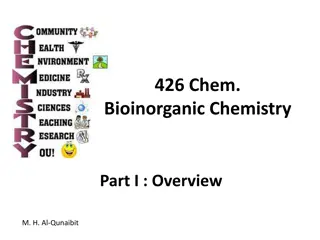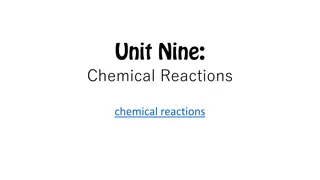Role of Chemistry in Modern Era - Natural Products and Chemical Engineering
Chemistry plays a crucial role in the modern era through the study of natural products, secondary metabolites, and chemically engineered extracts for various pharmaceutical and biological applications. This includes structural properties, chiral centers, aromatic rings, and functional groups found in natural products. The generation of chemically engineered extracts and the comparison of chromatograms highlight the significance of chemistry in understanding and utilizing natural compounds in different fields.
Uploaded on Feb 24, 2025 | 6 Views
Download Presentation

Please find below an Image/Link to download the presentation.
The content on the website is provided AS IS for your information and personal use only. It may not be sold, licensed, or shared on other websites without obtaining consent from the author.If you encounter any issues during the download, it is possible that the publisher has removed the file from their server.
You are allowed to download the files provided on this website for personal or commercial use, subject to the condition that they are used lawfully. All files are the property of their respective owners.
The content on the website is provided AS IS for your information and personal use only. It may not be sold, licensed, or shared on other websites without obtaining consent from the author.
E N D
Presentation Transcript
ROLE OF CHEMISTRY IN MODERN ERA Mohammad ARIF Assistant Professor Department Of Chemistry Govt. Degree College Kulgam
Natural product is the chemical substance or chemical compound produced by living organism found innature that usually has pharmacological or biological activity. Secondary metabolites produced by the organisms to help or protect itself within its own environmental niche are also natural products. The compound may be integral to the everyday existence of the organism but have serendipitous activity in unrelated biological systems. Products of natural origins can be called natural products
Natural products have distinguishing structural properties, measurable differences are the number of chiral centers, the degree of saturation, the presence of aromatic rings, and the number of the various heteroatoms. Natural product molecules are more compact, contain more oxygen atoms and less nitrogen atoms and lower number of aromatic rings in ea
FIG. 3. Percentages of molecules within the DNP that contain the fragments shown above. FIG. 4. Standard deviations (bars) and frequencies (diamonds) of structures containing the major functional groups found in the natural products (C=O, -OH, C=C, aromatic ring, and amide) in the four sets of virtual extracts : plant species (S1), plant genus (S2), type of metabolite (S3), and molecular weight (S4).
FIG. 5. Comparison of the chromatograms of 11 NEs and 11 CEEs: (a) percentage of peaks present only in the NEs; (b) percentage of peaks present only in the CEEs; (1) Conium maculatum (Apiaceae), (2) Urtica urensL. (Urticaceae), (3) Solanum diflorum Vell. (Solanaceae), (5) Matricaria recutita (Asteraceae) (6) Sonchus oleraceus (Asteraceae) (7) Brassica rapa (Brassicaceae) (9) Commelina erecta (Commelinaceae) (11) Sida rhombifolia (Malvaceae). (4) Morrenia brachystephana (Asclepiadaceae), (8) Solanum sisymbriifolium (Solanaceae) (10) Oenothera affinis Cambess (Onagraceae)
FIG. 12. Acetylcholinesterase inhibition by semisynthetic compound 6 isolated from the CEE prepared by reaction of C. maculatum NE with bromine. Compound 6 is produced from compound 7 present in the NE.
CONCLUSION Chemisry is playing a vital role in the designing and development of drugs for the treatment of various diseases of both developing and developed countries across the globe. Thank you Thank you























